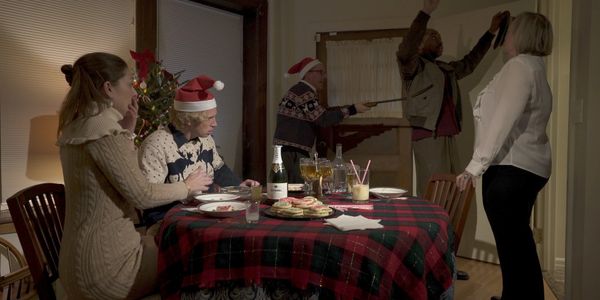Directed by Sophia Romma

USED AND BORROWED TIME is an experimental film directed by Sophia Romma.
This three and a half hours film is divided into two parts although this separation does not sanction a change of story or a time jump, but rather seems to recall the end of the first act of a theatre play. In fact, the whole structure of the film is very theatrical.
The direction, especially for the part that concerns the moment in which the protagonist travels through time and reaches her past, is purposely static: We can see a dining table, a barn, the wood, and the scene revolves especially around the actors.
The cinematography also contributes to this research and to this intent. Adding a theatrical signature to the work is also the presence of the orchestra led by the beautiful voice of Queen Ilise, who engages in various pieces, representing the only soundtrack of almost the entire film.
The story takes place in Alabama, it's inspired by a real episode that was told to the director and tells the life of a blind Jewish woman who travels from the present to her past.
She there reaches her 20-year-old self and the love of her life, an African American young man who dreamed about the end to segregation laws (we are in the 60s) but will have to clash with a family of racist and classist white Americans. So the woman, who too has been and still is a victim of racism and prejudice as a Jew (not only in the past but also in a present now far from the end of the Second World War), will live twice her nightmare.

The author defines her work as an experimental film and it's actually difficult, as a viewer, to be able to insert it within any already known category of film genre. In addition to the theatricality of the film, in fact, the duration is not a choice among the most popular in recent years.
There are also some illustrations (especially in the first part) that participate in the story in a metaphorical way and represent an external point of view.
Therefore a new and, indeed, experimental element. If Romma's work had to be labeled into a specific genre, I would think of a horror movie that uses words instead of images to scare the audience. In many of the phrases acted, especially by the actors who play the racist American family members, you get the same reaction that you can have in front of the crudest of horror films. It is the concepts that bleed and scare, not some part of the human body, and it's even scarier. There's no room for any "politically correct" kind of thing, and that's exactly what we liked.
A special mention goes to the costume design department (curated by Silvana Adamo and Dara Ponzo) and to the leading actresses Emily Seibert, who plays the young Eva Gold, and Cam Kornman, who plays Eva Gold in the present.
